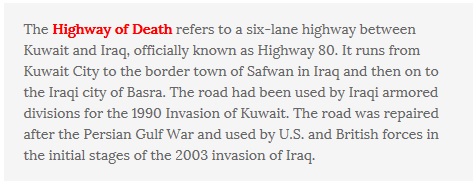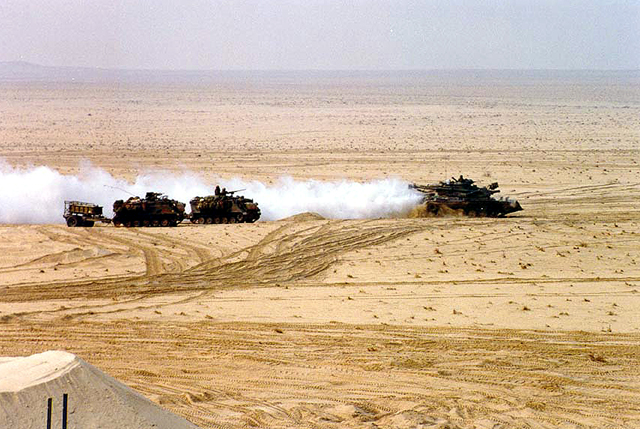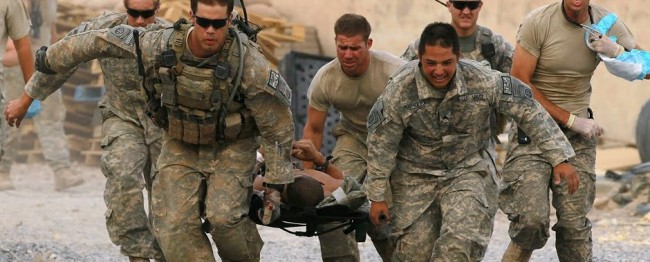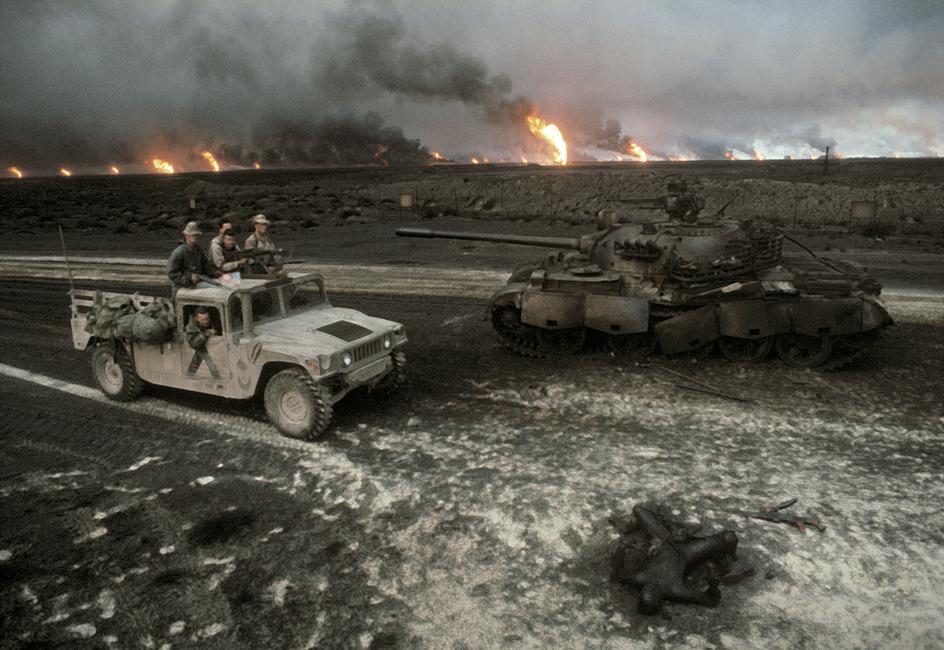Persian Gulf War
 The 1991 Persian Gulf War was a conflict between Iraq and a coalition force of 34 nations mandated by the United Nations and led by the United States.The lead up to the war began with the Iraqi invasion of Kuwait in August 1990 which was met with immediate economic sanctions by the United Nations against Iraq. Hostilities commenced in January 1991, resulting in a decisive victory for the coalition forces, which drove Iraqi forces out of Kuwait with minimal coalition deaths. The main battles were aerial and ground combat within Iraq, Kuwait and bordering areas of Saudi Arabia. The war did not expand outside of the immediate Iraq/Kuwait/Saudi border region, although Iraq fired missiles on Israeli cities.
The 1991 Persian Gulf War was a conflict between Iraq and a coalition force of 34 nations mandated by the United Nations and led by the United States.The lead up to the war began with the Iraqi invasion of Kuwait in August 1990 which was met with immediate economic sanctions by the United Nations against Iraq. Hostilities commenced in January 1991, resulting in a decisive victory for the coalition forces, which drove Iraqi forces out of Kuwait with minimal coalition deaths. The main battles were aerial and ground combat within Iraq, Kuwait and bordering areas of Saudi Arabia. The war did not expand outside of the immediate Iraq/Kuwait/Saudi border region, although Iraq fired missiles on Israeli cities.
Other common names for the conflict include the Gulf War, War in the Gulf, Iraq-Kuwait Conflict, UN-Iraq conflict, Operations Desert Shield, Desert Storm, Desert Sabre, 1990 Gulf War (for the Iraqi invasion of Kuwait), 1991 Gulf War (1990-1991), the Second Gulf War (to distinguish it from the Iran-Iraq war) and Gulf War Sr. and First Gulf War (to distinguish it from the 2003 invasion of Iraq). In Iraq, the war is often colloquially called simply Um M’aārak (“the Mother of All Battles”).
During the Iran-Iraq War of the 1980s, Kuwait was allied with Iraq, largely due to desiring Iraqi protection from Islamic Iran. After the war, Iraq was extremely
indebted to several Arab countries, including a $14 billion debt to Kuwait. Iraq hoped to repay its debts by raising the price of oil through OPEC oil production cuts, but instead, Kuwait increased production, lowering prices, in an attempt to leverage a better resolution of their border dispute. In addition, greatly antagonizing Iraq, Kuwait had taken advantage of the Iran-Iraq War and had begun illegal slant drilling for oil into Iraqi reserves, and had built military outposts on Iraqi soil near Kuwait. Furthermore, Iraq charged that it had performed a collective service for all Arabs by acting as a buffer against Iran and that therefore Kuwait and Saudi Arabia should negotiate or cancel Iraq’s war debts. Hussein’s primary two-fold justification blended the assertion of Kuwaiti territory being an Iraqi province arbitrarily cut off by imperialism, and the use of annexation as retaliation for “economic warfare” Kuwait had waged through slant drilling into Iraq’s oil supplies while under Iraqi protection.
The war with Iran had also seen the destruction of almost all of Iraq’s port facilities on the Persian Gulf cutting off Iraq’s main trade outlet. Many in Iraq, expecting a resumption of war with Iran in the future, felt that Iraq security could only be guaranteed by controlling more of the Gulf Coast, including more secure ports. Kuwait thus made a tempting target.
Ideologically, the invasion of Kuwait was justified through calls to Arab nationalism. Kuwait was described as a natural part of Iraq carved off by British imperialism. The annexation of Kuwait was described as a step on the way to greater Arab union. Other reasons were given as well. Iraqi president Saddam Hussein presented it as a way to restore the empire of Babylon in addition to the Arab nationalist rhetoric. The invasion was also closely tied to other events in the Middle East. The First Intifada by the Palestinians was raging, and most Arab states, including Kuwait, Saudi Arabia and Egypt, were dependent on western alliances. Saddam thus presented himself as the one Arab statesman willing to stand up to Israel and the U.S.
During the Iran-Iraq war, U.S.-Iraqi relations had warmed, as the U.S. found it useful to “tilt” toward Iraq. Following the war, however, there were moves within the United States Congress to isolate Iraq diplomatically and economically over concerns about human rights violations, its dramatic military build-up, and hostility to Israel. Opposition to the regime in Iraq was thus shared by many on the left-wing as well as some neoconservatives, most prominently Paul Wolfowitz. These moves were disowned by high-ranking US senators like Robert Dole, who told Iraqi President Hussein that “Congress does not represent U.S. President George H. W. Bush or the government” and that Bush would veto any move toward sanctions against Iraq. (From the Iraqi transcript of the meeting, as published in Sifry et al, 1991.)
In late July, 1990, as negotiations between Iraq and Kuwait stalled, Iraq massed troops on Kuwait’s borders and summoned American ambassador April Glaspie for an unanticipated meeting with Iraqi President Saddam Hussein. In that meeting, Saddam outlined his grievances against Kuwait, while promising that he would not invade Kuwait before one more round of negotiations. Although Glaspie expressed concern over the troop buildup, some people perceived her answers as giving tacit approval for an invasion, by saying that the US “[has] no opinion on the Arab-Arab conflicts, like your border disagreement with Kuwait” (from the Iraqi transcript of the meeting, as published in Sifry). To emphasize this point, she also said at the meeting, “James Baker has directed our official spokesmen to emphasize this instruction.” Although ambassador Glaspie shortly after left the foreign service, US sources say that she had handled everything “by the book” and had not signaled Iraqi President Saddam Hussein any approval for defying the Arab League’s Jeddah crisis squad which conducted the negotiations. However, Saddam’s expectations may have been preoccupied by the perception that the US just at this time was approving the reunification of Germany, another act that he considered to be nothing more than the nullification of an artificial, internal border.
At the break of dawn on August 2, 1990, Iraqi troops crossed the Kuwaiti border with armor and infantry, occupying strategic posts throughout the country, including the Emir’s palace. The Kuwaiti Army was quickly overwhelmed, though they bought enough time for the Kuwaiti Air Force to flee to Saudi Arabia. Troops looted medical and food supplies, detained thousands of civilians and took over the media. Iraq detained thousands of Western visitors as hostages and later attempted to use them as bargaining chips. Hussein then installed a new Iraqi provincial governor, described as “liberation” from the Kuwaiti Emir; this was largely dismissed as war propaganda.
Within hours of the initial invasion, the Kuwaiti and United States of America delegations requested a meeting of the UN Security Council, which passed Resolution 660, condemning the invasion and demanding a withdrawal of Iraqi troops. On August 3, the Arab League passed its own resolution condemning the invasion and demanding a withdrawal of Iraqi troops. The Arab League resolution also called for a solution to the conflict from within the Arab League, and warned against foreign intervention. On August 6, the Security Council passed Resolution 661, placing economic sanctions on Iraq.
The decision by the west to repel the Iraqi invasion had as much to do with preventing an Iraqi invasion of Saudi Arabia, a nation of far more importance to the world than Kuwait. The rapid success of the Iraqi army against Kuwait had brought Iraq’s army within easy striking distance of the Hama oil fields, Saudi Arabia’s most valuable oil fields. Iraqi control of these fields as well as Kuwait and Iraqi reserves would have given it an unprecedented monopoly in the vital commodity. Saudi Arabia could put up little more resistance than Kuwait and the entire world believed the temptation for Saddam to further advance his ambitions would prove too great. The entire world — especially the oil hungry states of the United States, Europe and Japan — saw such an oil monopoly as very dangerous.
Iraq had a number of grievances with Saudi Arabia. The concern over debts stemming from the Iran-Iraq war was even greater when applied to Saudi Arabia, which Iraq owed some 26 billion dollars. The long desert border was also ill-defined. Rapidly after his victory over Kuwait Saddam began verbally attacking the Saudi kingdom. He argued that the American-supported Kingdom was an illegitimate guardian of holy cities of Mecca and Medina. Saddam combined the language of the Islamist groups that had recently fought in Afghanistan with the rhetoric Iran had long used to attack the Saudis. The addition of Allahu Akbar to the flag of Iraq and images of Saddam praying in Kuwait were part of a plan to win the support of the Muslim Brotherhood and detach Islamist Mujahideen from Saudi Arabia. These attacks on Saudi Arabia escalated as western troops poured into the country.
President George H. W. Bush quickly announced that the US would launch a “wholly defensive” mission to prevent Iraq from invading Saudi Arabia – Operation Desert Shield, and US troops moved into Saudi Arabia on August 7. On August 8, Iraq declared parts of Kuwait to be extensions of the Iraqi province of Basra and the rest to be the 19th province of Iraq.
The United States navy mobilised two naval battle groups, USS Dwight D. Eisenhower and USS Independence, to the area , where they were ready by August 8. The United States also sent the battleships USS Missouri and USS Wisconsin to the region, and they would later become the last battleships to actively participate in a foreign war. Military buildup continued from there, eventually reaching 500,000 troops. The consensus among military analysts is that until October, the American military forces in the area would have been insufficient to stop an invasion of Saudi Arabia had Iraq attempted one.
A long series of UN Security Council and Arab League resolutions were passed regarding the conflict. One of the most important was Resolution 678, passed on November 29, giving Iraq a withdrawal deadline of January 15, 1991, and authorizing “all necessary means to uphold and implement Resolution 660”, a diplomatic formulation authorizing the use of force.
The United States, especially Secretary of State James Baker, assembled a coalition of forces to join it in opposing Iraq, consisting of soldiers from 34 countries: Afghanistan, Argentina, Australia, Bahrain, Bangladesh, Canada, Czechoslovakia, Denmark, Egypt, France, Germany, Greece, Hungary, Honduras, Italy, Kuwait, Morocco, The Netherlands, Niger, Norway, Oman, Pakistan, Poland, Portugal, Qatar, Saudi Arabia, Senegal, South Korea, Spain, Syria, Turkey, the United Arab Emirates, the United Kingdom and the United States itself. US troops represented 74% of 660,000 troops in the theater of war. Many of the coalition forces were reluctant to join; some felt that the war was an internal Arab affair; others feared increasing American influence in Kuwait. In the end, many nations were persuaded by offers of economic aid or debt forgiveness.
The United States went through a number of different public justifications for their involvement in the conflict. The first reasons given were the importance of oil to the American economy and the United States’ longstanding friendly relationship with Saudi Arabia . However, some Americans were dissatisfied with these explanations and “No Blood For Oil” became a rallying cry for domestic peace activists, though opposition never reached the size of opposition to the Vietnam War. Later justifications for the war included Iraq’s history of human rights abuses under President Saddam Hussein, the potential that Iraq may develop nuclear weapons or weapons of mass destruction, and that “naked aggression [against Kuwait] will not stand.” In Canada this was the main argument; Canada had long opposed unilateral aggression, including those by the United States, and used this as the argument for intervention.
Shortly after Iraq’s invasion of Kuwait, the organization Citizens for a Free Kuwait was formed in the US. It hired the public relations firm Hill and Knowlton for about $11 million, money from the Kuwaiti government. This firm went on to manufacture a fake campaign, which described Iraqi soldiers pulling babies out of incubators in Kuwaiti hospitals and letting them die on the floor. A video news release was widely distributed by US TV networks; false supporting testimony was given before Congress and before the UN Security Council. The fifteen-year-old girl testifying before Congress was later revealed to be the daughter of the Kuwaiti ambassador to the United States; the supposed surgeon testifying at the UN was in fact a dentist who later admitted to having lied.
Various peace proposals were floated, but none were agreed to. The United States insisted that the only acceptable terms for peace were Iraq’s full, unconditional withdrawal from Kuwait. Iraq insisted that withdrawal from Kuwait must be “linked” to a simultaneous withdrawal of Syrian troops from Lebanon and Israeli troops from the West Bank, Gaza Strip, the Golan Heights, and southern Lebanon. On January 12, 1991 the United States Congress authorized the use of military force to drive Iraq out of Kuwait. Soon after the other states in the coalition did the same.
A day after the deadline set in Resolution 678, the coalition launched a massive air campaign codenamed Operation Desert Storm: more than 1,000 sorties per day, beginning early morning on January 17, 1991. Weapons used included smart bombs, cluster bombs, daisy cutters and cruise missiles. Iraq responded by launching 8 Scud missiles into Israel the next day. The first priority for coalition forces was destruction of the Iraqi air force and anti-aircraft facilities. This was quickly achieved and for the duration of the war Coalition aircraft could operate largely unchallenged. Despite Iraq’s better-than-expected anti-aircraft capabilities, only one coalition aircraft was lost in the opening day of the war. Stealth aircraft were heavily used in this phase to elude Iraq’s extensive SAM systems and anti-aircraft weapons; once these were destroyed, other types of aircraft could more safely be used. The sorties were launched mostly from Saudi Arabia and the six coalition aircraft carrier groups in the Persian Gulf.
The next Coalition targets were command and communication facilities. Saddam had closely micromanaged the Iraqi forces in the Iran-Iraq War and initiative at the lower levels was discouraged. Coalition planners hoped Iraqi resistance would quickly collapse if deprived of command and control. The first week of the air war saw a few Iraqi sorties but these did little damage, and thirty-eight Iraqi MiGs were shot down by Coalition planes. Soon after, the Iraqi airforce began fleeing to Iran. On January 23, Iraq began dumping approximately 1 million tons of crude oil into the gulf, causing the largest oil spill in history.
The third and largest phase of the air campaign targeted military targets throughout Iraq and Kuwait: Scud missile launchers, weapons of mass destruction sites, weapons research facilities and naval forces. About one third of the Coalition airpower was devoted to attacking Scuds. In addition, it targeted facilities useful for both the military and civilians: electricity production facilities, telecommunications equipment, port facilities, oil refineries and distribution, railroads and bridges. Two live nuclear reactors were bombed, in violation of the recently passed UN Resolution 45/52 banning such attacks. Electrical power facilities were destroyed across the country. At the end of the war, electricity production was at four percent of its pre-war levels. Bombs destroyed the utility of all major dams, most major pumping stations and many sewage treatment plants. In most cases, the Allies avoided hitting civilian-only facilities. However, on February 13, 1991, two laser-guided “smart bombs” destroyed an air raid shelter in Baghdad killing hundreds of Iraqis. U.S. officials claimed that the bunker was a military communications center, but Western reporters have been unable to find evidence for this.
Iraq launched missile attacks on coalition bases in Saudi Arabia and on Israel, in the hopes of drawing Israel into the war and drawing other Arab states out of it. This strategy proved ineffective. Israel did not join the coalition, and all Arab states stayed in the coalition except Jordan, which remained officially neutral throughout. On January 29, Iraq attacked and occupied the abandoned Saudi city of Khafji with tanks and infantry. However, Battle of Khafji ended when Iraqis were driven back by Saudi Arabia and Qatar forces supported by U.S. Marines with close air support over the following two days.
On February 22, 1991, Iraq agreed to a Soviet-proposed cease-fire agreement. The agreement called for Iraq to withdraw troops to pre-invasion positions within three weeks following a total cease-fire, and called for monitoring of the cease-fire and withdrawal to be overseen by the UN Security Council. The US rejected the proposal but said that retreating Iraqi forces would not be attacked, and gave twenty-four hours for Iraq to begin withdrawing forces.
On February 24, the US began Operation Desert Sabre, the ground portion of its campaign. US forces pulled plows along Iraqi trenches, burying their occupants alive. Soon after, a convoy of Marines penetrated deep into Iraqi territory, collecting thousands of deserting Iraqi troops, weakened and demoralized by the extensive air campaign. The US anticipated that Iraq might use chemical weapons; General Colin Powell later suggested that a US response to such an act might have been to destroy dams on the Tigris and Euphrates rivers, drowning Baghdad in water, though this was never fully developed as a plan.
The United States originally hoped that Saddam would be overthrown in an internal coup, and used CIA assets in Iraq to organize a revolt. When a popular rebellion against Saddam began in southern Iraq, the United States did not support it due to the fact that the coalition refused to aid in an invasion (and also due to various policy changes within the United States). As a result, not only was the rebellion brutally subdued, but the main CIA operative who was tasked with organizing the revolt was disavowed and accused of “disobeying orders to not organize a revolt”. In their cowritten 1998 book, “A World Transformed” George Bush the Elder and Brent Scowcroft discussed regime change in Iraq:
Trying to eliminate Saddam [in 1991], extending the ground war into an occupation of Iraq, would have violated our guidelines about not changing objectives in midstream, engaging in ‘mission creep’, and would have incurred incalculable human and political costs… Would have have been forced to occupy Baghdad and, in effect, rule Iraq. The coalition would instantly have collapsed, the Arabs deserting in anger and other allies pulling out as well. Under those circumstances, there was no viable ‘exit strategy’ we could see, violating another of our principles… Had we gone the invasion route, the United States could conceivably still be an occupying power in a bitterly hostile land. It would have been a dramatically different – and perhaps barren – outcome.”
Iraq did not use chemical weapons and the allied advance was much swifter than US generals expected. On February 26, Iraqi troops began retreating out of Kuwait, setting fire to Kuwaiti oil fields as they left. A long convoy of retreating Iraqi troops — along with Iraqi and Palestinian civilians — formed along the main Iraq-Kuwait highway. This convoy was bombed so extensively by the Allies that it came to be known as the Highway of Death. One hundred hours after the ground campaign started, President Bush declared a ceasefire and on February 27 declared that Kuwait had been liberated. Journalist Seymour Hersh has charged that, two days after the ceasefire was declared, American troops led by Barry McCaffrey engaged in a systematic massacre of retreating Iraqi troops, in addition to some civilians. McCaffrey has denied the charges and an army investigation has cleared him.
A peace conference was held in allied-occupied Iraq. At the conference, Iraq negotiated use of armed helicopters on their side of the temporary border. Soon after, these helicopters — and much of the Iraqi armed forces — were refocused toward fighting against a Shiite uprising in the south. In the North, Kurdish leaders took heart in American statements that they would support a people’s uprising and began fighting, in the hopes of triggering a coup. However, when no American support was forthcoming, Iraqi generals remained loyal and brutally crushed the Kurdish troops. Millions of Kurds fled across the mountains to Kurdish areas of Turkey and Iran. These incidents would later result in no-fly zones in both the North and the South. In Kuwait, the Emir’s dictatorship was restored and suspected Iraqi collaborators were attacked extra-judicially, especially Palestinians. Eventually, over 400,000 people were expelled from the country.
Hundreds of Kuwaiti oil wells were ablaze and 1.5 millions barrels per day of oil were pouring into the Gulf.
On March 10, 1991, Operation Desert Farewell began to move 540,000 American troops out of the Persian Gulf.
Source : sheppardsoftware
RELATED TOPIC
 For more detail CLIKE ME
For more detail CLIKE ME










very sad incident for both countries iraq and kuwait .Why Saddam Hussain..ba eye on silence country kuwait..as he is president of BIG IRAQ COUNTRY AND LATER PUNISHED..
Very very sad
very sad
https://www.facebook.com/KuwaitEatOuts